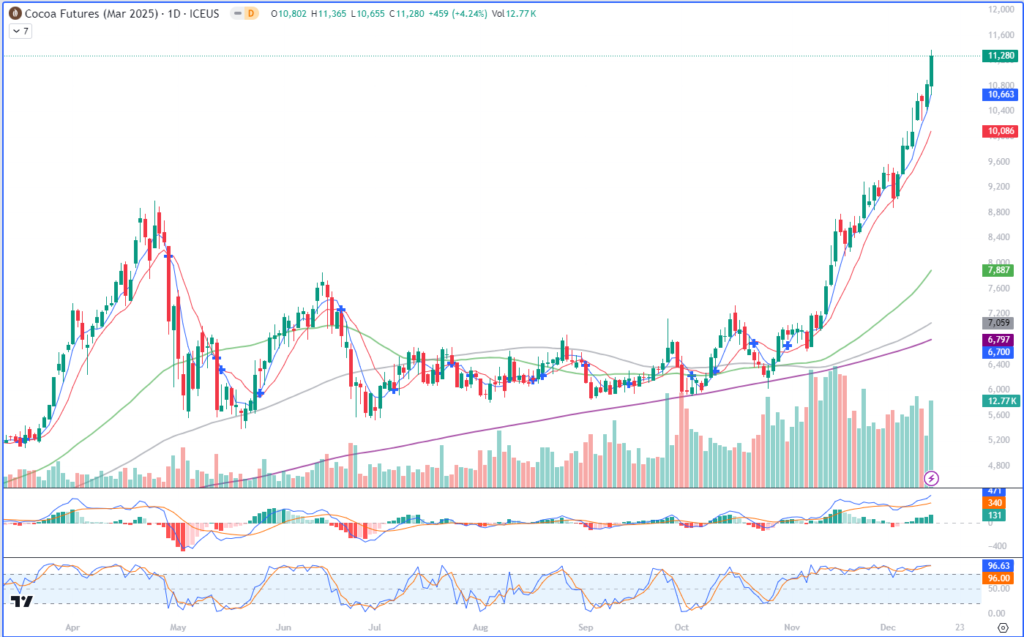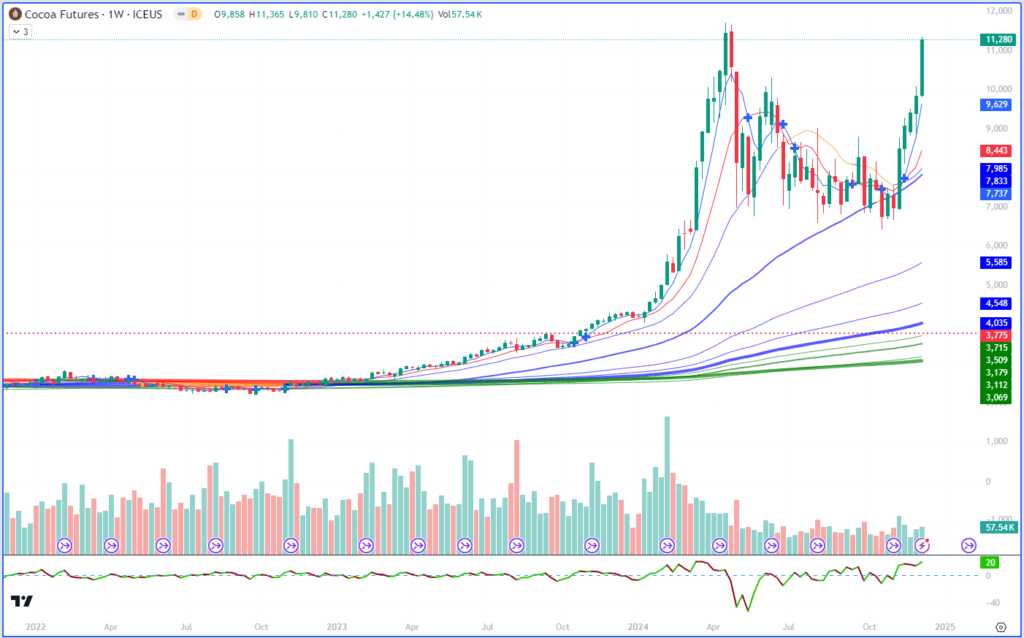The information and opinions expressed below are based on my analysis of price behavior and chart activity
March Cocoa

Today, March Cocoa closed up 459 to 11280. Since the market made it’s last significant low, on Oct 25th, it has rallied an astounding 5349 pts., or 88.91%, from low to high. This rally has been spurred by 2 things, I think. The first is the weather. The west coast of Africa is where the bulk of the world’s Cocoa comes from. Currently, dry weather there is said to be hurting the yield potential for the mid-year crop in April. There is also anticipation that their seasonal Harmattan winds (a cool and dry wind, sometimes a dust/sand storm that emanates from the Sahara.) will further reduce those yields. Recent harvest from the Ivory Coast indicates a sharp decline in quality of the beans, as well. The world supply/demand situation is the second item affecting prices. The International Cocoa Association raised (lowered?) their estimate to a deficit of 478,000 metric tons. That was a change from their previous estimate of a deficit of 462,000 in May. If the -478k is accurate, that would be the lowest (worst) deficit in some 60 years. World production is said to be down about 13% y/y. There have also been some curious financial moves by Ghana’s Cocobod agency. It’s my understanding that historically, they have financed, purchased and sold the Ghana Cocoa crop. Up until this year and this crop, Cocoa farmers just had to worry about the crops. Now they have to work on the crops, obtaining financing and marketing the crops. It’s also my understanding that Cocobod does not have the physical beans to fulfil their obligations, both past and present. That’s said to be the reason they got out of the financing. I think they overcommitted to purchases and sales. The crops wasn’t available for them to purchase last harvest, but they made their usual commitments of sales. Interest rates rising around the world also meant that they were unable to get attractive rates and, therefore, left all of the farmers, producers and importers they deal with swinging in the wind. I don’t think they’ve defaulted on anything, just re-worked some contracts to push the agreements down the road a bit. So combining the weather events with the supply and demand side leads the Cocoa market to where it is, to my eye. Can it keep going? I think so. Earlier this year, the May contract topped out at 12261 in mid-April of this year. That corresponds with the mid-year harvest time-frame. The weekly chart (below) show that the market retraced this past summer and fall and found support near the 7000 level. Coincidentally, that roughly corresponds with a 50% retracement from the 2022 lows. That little red dotted line is at 3775 was the previous all-time contract high, set in March of 2011. Prices broke up through that in October of 2023 and haven’t really looked back. It seems to me that a test of the May 2023 high is likely. Given the wildly bullish momentum the market currently has, I also think we’re likely to see a significant push past there. Support and resistance levels are tough to ascertain when markets are pushing into uncharted ranges. As far as support goes, the 5-day and 10-day moving averages are the closest ones that I follow, and those values are at 10,663 and 10,086, respectively. Last weeks high is just above the 10-day at 10,092. IF the market were to begin a retracement next Monday, the first Fibonacci level is at 10,103, the second at 9,322 and the 50% level is at 8,691. Those are based on the Oct 25th low to today’s high. Resistance from here is likely to be found near the previous highs, 12,261. From there, I would set targets at round numbers like 13,000, 13,500, 14,000, etc. Aggressive and well-margined traders may do well to consider long positions. If you’re not the patient type and willing to wait for a significant pullback, consider using Pivot Points to set an intra-day entry point. Pivots change every day, so if you want to learn more about them and how they might be used to identify potential entry or exit points, please give me a call or drop me an email. Seasonally, prices have a tendency to settle back through the month of December, before beginning a rally the first week in January. I don’t think the seasonals are really in play, right now, as fundamental conditions have worsened. Be aware that this market is make large moves on a daily basis and volatility can be high if prices start to waver. Protective stops against futures positions are advised, but Put options can also be used to manage position risk effectively. If you have any questions about Cocoa or any other markets that you’ve seen me write about (and even ones that I haven’t covered here yet) reach out and ask. I’ll answer anything for you that I can.
Cocoa Weekly Continuous Chart

Jefferson Fosse Walsh Trading
Direct 312 957 8248 Toll Free 800 556 9411
jfosse@walshtrading.com www.walshtrading.com
Walsh Trading, Inc. is registered as a Guaranteed Introducing Broker with the Commodity Futures Trading Commission and an NFA Member.
Futures and options trading involves substantial risk and is not suitable for all investors. Therefore, individuals should carefully consider their financial condition in deciding whether to trade. Option traders should be aware that the exercise of a long option will result in a futures position. The valuation of futures and options may fluctuate, and as a result, clients may lose more than their original investment. The information contained on this site is the opinion of the writer or was obtained from sources cited within the commentary. The impact on market prices due to seasonal or market cycles and current news events may already be reflected in market prices. PAST PERFORMANCE IS NOT NECESSARILY INDICATIVE OF FUTURE RESULTS. All information, communications, publications, and reports, including this specific material, used and distributed by Walsh Trading, Inc. (“WTI”) shall be construed as a solicitation for entering into a derivatives transaction. WTI does not distribute research reports, employ research analysts, or maintain a research department as defined in CFTC Regulation 1.71.
